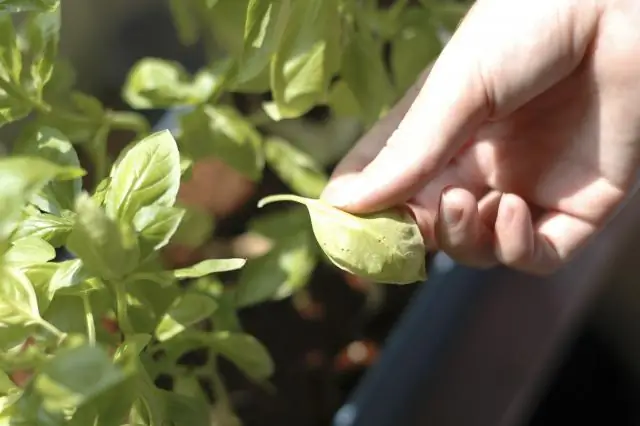
Table of contents:
- Author Bailey Albertson [email protected].
- Public 2024-01-17 22:26.
- Last modified 2025-06-01 07:32.
Good luck will not leave without a crop: a description of a popular domestic potato variety

In our country, potatoes are considered a traditional food product, and they deserved this status. The description of the characteristics of the nutritious tuber confirms that it is the best suited for the climatic conditions of Russian latitudes: it is easy to grow, relatively unpretentious to the temperature regime, and easy to store. Excellent taste allows this vegetable to be present simultaneously in several dishes on the table. And although potato varieties are very diverse on the market, it was Luck that won popular recognition.
Content
-
1 Description of the variety and photo of potatoes Luck
1.1 Table: advantages and disadvantages of the variety
-
2 Growing potatoes of the Luck variety
-
2.1 Seed preparation
2.1.1 Video: preparing potatoes for planting
- 2.2 Landing Luck
- 2.3 Table: potato care
- 2.4 Table: application time and composition of top dressing
- 2.5 Productivity of the variety
-
-
3 Diseases, pests and methods of their control
- 3.1 Photo gallery: diseases and pests
- 3.2 Table: diseases, pests and methods of their control
-
4 Harvesting and storage
4.1 Video: Young Potatoes Luck
- 5 Reviews
Description of the variety and photo of potatoes Luck
The variety owes its origin to the employees of the A. G. Lorkh Research Institute of Potato Economy, who at the end of the last century set out to obtain potato samples that could demonstrate high yield rates, despite the type of soil and climate conditions. The task was successfully solved in a short time, and the variety, which has a high resistance to negative environmental factors, showed the level of collection of high-quality tubers up to 45 tons per hectare in various regions of our vast state.

The Udacha variety is characterized by a high yield.
The aerial part of the plant reaches a height of 40-45 cm. The shape of the bushes is spreading, the leaves are densely scattered along the stem, white flowers are combined into inflorescences. Oval-rounded tubers are covered with a smooth thin skin of light yellow color with a small number of eyes, which distinguishes this variety from most others, whose representatives have a less pleasant appearance. The peel hides under it a dense white pulp, which, when cooked, can be supplemented with a yellow tint, which is quite acceptable, especially if mineral fertilizers were used during feeding. The starch content in tubers ranges from 12-14%.
With proper care, the ripening period ends 60 days after the first shoots have cut through the soil. Taste test samples can be dug out after 40-45 days. The number of tubers in a bush reaches 10-15, the average weight of an individual root crop is 150 grams, that is, with a responsible approach to cultivation, one ditch may contain 1.5-2.25 kg of a pure product of good keeping quality. Gardeners express themselves only in a positive way about the taste of tubers, noting both the special tenderness of the pulp, which is excellent for mashed potatoes, and the appetizing dense structure of fried potato slices.

Good luck in the bag!
Summarizing the characteristics of the variety under consideration, one should also point out its weak points.
Table: advantages and disadvantages of the variety
| Benefits | disadvantages |
|
|
As you can see, the number of shortcomings is insignificant, and all of them can be eliminated by observing the landing technique.
Growing potatoes of the Luck variety
Although the cultivar is distinguished by its high yield regardless of soil type, this does not mean that such potatoes do not need to be looked after. Preparation for planting begins in the fall. Immediately you need to take into account that it is better to place potatoes in such a soil where green manure plants, legumes and melons, cabbage or cucumbers previously grew. If the potato planting site is not changed annually, then the likelihood of degeneration of the variety is high, which is expressed in a loss of taste, as well as an increasing susceptibility to infection.
In the autumn period, the area where the vegetable is supposed to be planted should be thoroughly dug up, reaching a 20-centimeter depth, having previously introduced compost into the soil at the rate of 40 buckets per hundred square meters. With the arrival of spring, the soil is leveled, adding mineral fertilizers if necessary.
Seed preparation
When choosing planting material, you need to pay attention to whole medium-sized tubers, which do not show signs of disease or traces of mechanical damage. If there are not enough of them, then large potatoes are selected. They are cut into several parts with the condition that at least three eyes remain on each fragment. After each operation, the knife is dipped in a strong solution of manganese in order to avoid the transmission of viruses and pathogenic bacteria. After completing the selection of material for planting, the germination phase follows, which lasts about 15-20 days … Potatoes, neatly laid out in boxes, are placed in a room with access to sunlight and fresh air, with a temperature of 10-15 ºC, but not higher than 18 ºC. It is important to keep track of the length of the shoots - too long will easily break off.
Video: preparing potatoes for planting
Landing Luck
Before planting, it is recommended to treat potatoes with special disinfectants. When choosing the time to plant, you need to track that the soil warms up to 10 ºC. From this threshold, the optimum temperature for this variety begins. Usually this time falls on the end of April - beginning of May.
When planting, a distance of 60-70 cm should be observed between rows, and 20-25 cm between tubers. The size and condition of the planting material are interrelated with the planting depth. A whole medium-sized tuber is placed at a depth of 10 cm. Small and cut potatoes are deepened by 5-6 cm. A handful of compost mixed with ash in equal proportions is introduced into the hole to increase the yield. The tubercles resulting after planting do not need to be trampled down and crushed. They should be raked to allow the plants to get more moisture.

The emerging shoots should be immediately spud
It would be nice to cover the sprouts that have appeared with a special material. If there is none, then the first stalks should be well covered with earth.

Potatoes should be spud several times per season.
Table: potato care
| Operation | Time spending |
| Weeding | As the weeds grow |
| Loosening | It is combined with weeding, but the first time loosening is carried out during the appearance of the first shoots |
| Top dressing | Introduced when loosening the beds |
| Secondary hilling | It is carried out when the height of the bushes reaches 20 cm; recommended after rain |
| Watering | It becomes necessary only in extreme heat and with prolonged drought. |
Top dressing is made at the rate of 0.5 liters per 1 bush. The timing and composition of top dressing for 10 liters of water are suggested in the table.
Table: application time and composition of top dressing
| Time | Structure |
| First shoots |
|
| The beginning of flowering |
|
| Flowering period |
|
The yield of the variety
The potato variety Luck is distinguished by excellent yield indicators. It is capable of providing a guaranteed high yield in different climatic zones (about 40-45 t / ha).
Diseases, pests and methods of dealing with them
Although the Udacha variety is highly resistant to many diseases, late blight can easily affect the yield. The same goes for the stem nematode, the Colorado potato beetle and the bear.
Photo gallery: diseases and pests
-

Colorado beetle - Colorado potato beetle is the most common pest of potatoes
-

bear - The bear damages potato tubers
-

Stem nematoda - Potato tubers can be infected with stem nematode
-

Late blight on a tuber - Tuber infected with infection is unfit for consumption
-

Late blight on leaves - Leaves and stems are often affected by late blight
Control methods are shown in the table.
Table: diseases, pests and methods of controlling them
| Disease / pest | Signs of defeat | Preventive actions | Control methods |
| Late blight |
|
|
|
| Stem nematode |
|
Adding 1 tablespoon of wood ash to the hole when planting | Digging up and destroying diseased plants |
| Colorado beetle | Deceleration of plant development | Planting plants with a strong odor (marigolds, dill, calendula) in the immediate vicinity of potatoes |
|
| Medvedka | The appearance of characteristic tuber damage |
|
Treatment of the landing site with soapy water (2 pieces of laundry soap for 10 liters of water) |
Harvesting and storage
Already at the end of June, the tops of potatoes Luck begins to turn yellow. This means that the first crop can be harvested. The bush is dug out with a shovel or pitchfork, prying it and pulling the tops. Collect the tubers in a bucket or first pile them up so that they dry better in the sun in the fresh air.
Having dug a garden bed, before storage, the crop is sorted out: the potatoes damaged by the disease and accidentally cut with a shovel are removed, the rest are sprayed with copper sulfate, this will improve their safety. Having poured the crop into prepared boxes, containers or bags, they are transferred to the basement, where the air temperature is not higher than 4 degrees Celsius, otherwise the germination of tubers will begin.

One of the most popular storage options for potatoes is in bags
To prevent rotting and good air circulation, the layer of potatoes in the boxes should be no more than one and a half meters, it is recommended to store the crop not on the ground, but on stands. Observing these conditions, keep Luck until the next harvest. The taste and appearance of the potatoes are not compromised.
Video: young potatoes Luck
Reviews
Potatoes of the Udacha variety have been grown on personal plots and in agricultural complexes for more than a decade. Its positive characteristics have passed the test of time with dignity, which means that it will be popular for a very long time.
Recommended:
Growing Rosemary In An Apartment: Planting, Care And Other Nuances

Details about growing rosemary in an apartment: planting, care, reproduction. Features of the plant that you need to pay attention to
Garden Strawberry Variety Tsaritsa - Features, Care And Other Important Aspects + Photo

Description of the garden strawberry variety Tsaritsa. Advantages and disadvantages. Planting, care and reproduction. Disease and pest control. Harvesting. Gardeners reviews
How To Properly Store Mink And Other Fur Coats In The Summer: Preparation, Conditions, Nuances + Video And Reviews

How to store a fur coat in the summer. What you need to know about storing products from different types of fur. Optimal conditions. Fatal mistakes of summer storage and how to fix them
Chamora Turusi Variety Of Garden Strawberries - Features, Care And Other Important Aspects, The Difference Between Strawberries And Garden Strawberries + Photo

Everything about the Chamora Turusi strawberry variety: from planting and care to picking berries. Productivity, terms of fruiting, reviews of gardeners
Bobtail: Characteristics Of The Breed, Photo Of A Cat, How To Feed And Care For, How To Choose A Kitten, Reviews Of Cat Owners

Varieties of bobtails: Kuril, Karelian, Japanese, Mekong, American. The history of the origin of the breed. Features and care. Breeding. Reviews
